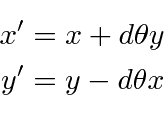Next: The Commutators of the Up: Derivations and Computations Previous: Derivations and Computations Contents
In three dimensions, this means that we can change our coordinates by rotating about
any one of the axes and the equations should not change.
Lets try and infinitesimal rotation about the
![]() axis.
The
axis.
The
![]() and
and
![]() coordinates will change.
coordinates will change.



Now we Taylor expand this equation.


![\begin{displaymath}\bgroup\color{black} \left[H,{\hbar\over i}\left(x{\partial\over\partial y}-y{\partial\over\partial x}\right)\right]=0 \egroup\end{displaymath}](img1745.png)


We could have done infinitesimal rotations about the
![]() or
or
![]() axes and shown that
all the components of the angular momentum operator commute with the Hamiltonian.
axes and shown that
all the components of the angular momentum operator commute with the Hamiltonian.
![\begin{displaymath}\bgroup\color{black}[H,L_z]=[H,L_x]=[H,L_y]=0\egroup\end{displaymath}](img234.png)
Remember that operators that commute with the Hamiltonian imply physical quantities that are conserved.
Jim Branson 2013-04-22